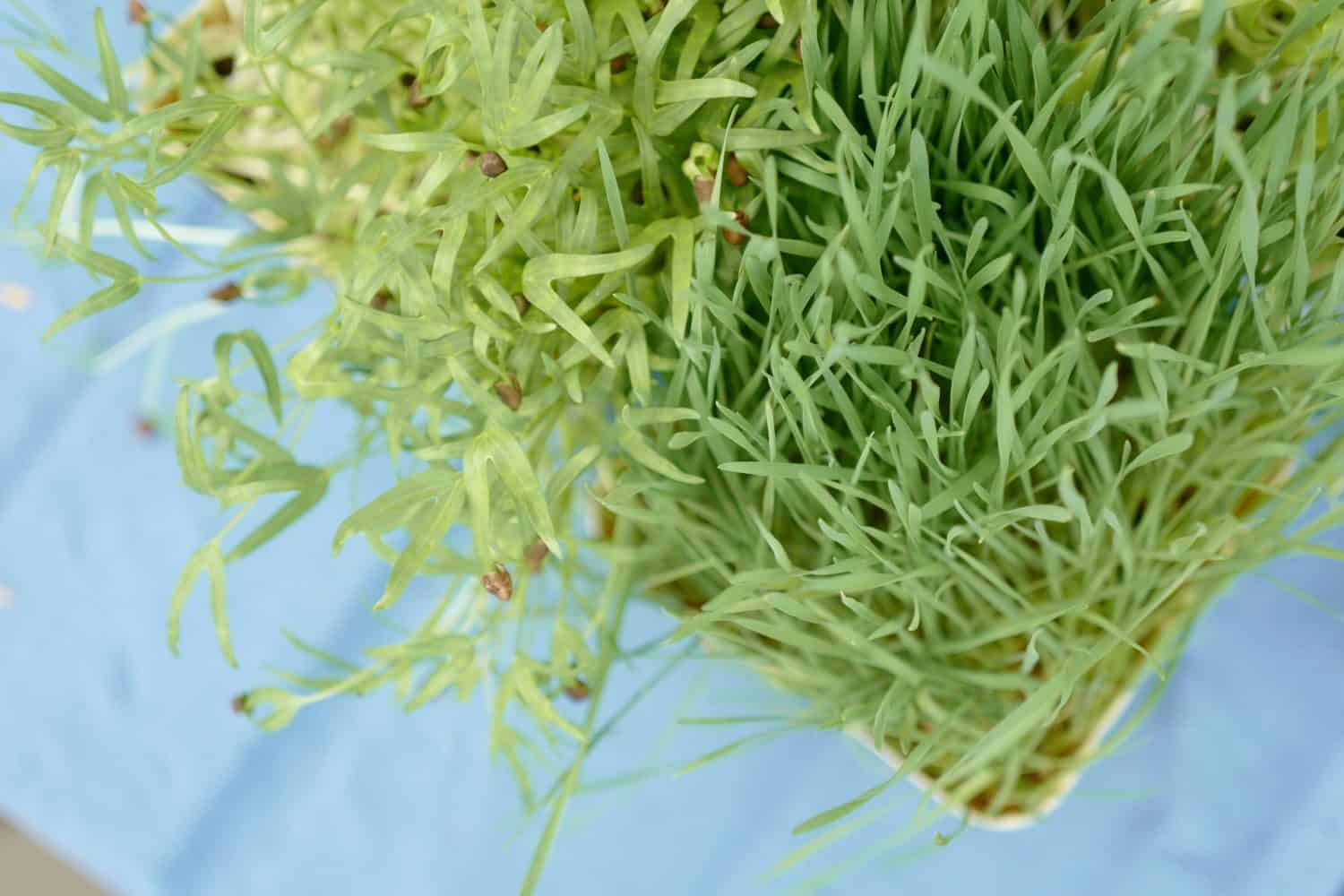The debate on artificial grass vs. natural grass rages in millions of households. While lawns made of natural grass are the traditional choice, homeowners are increasingly turning to synthetic alternatives. The artificial turf market is forecast to reach $7 billion by 2025 and comprises contact sport and landscaping sectors. Overall, European sales dominate the market, followed by North America, and there is no doubt that artificial lawns appeal to many householders and organizations. However, it is not without its opponents, and others argue that artificial grass is not the perfect solution to gardening challenges that it claims to be. Here, we look at all the key factors you should consider before deciding whether to install natural or artificial grass in your garden.
What Is Artificial Grass?
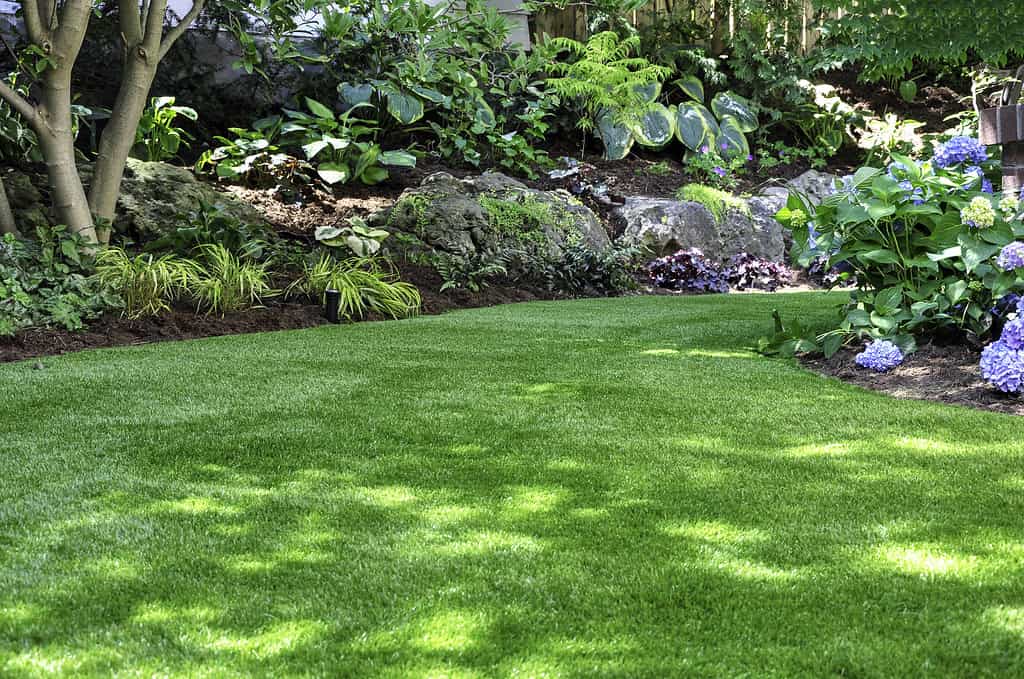
Artificial grass is made from two types of polymers.
©Joanne Dale/iStock via Getty Images
Artificial grass, synthetic grass, and artificial turf are all names for fake products used as an alternative to natural grass lawns on sports pitches or for landscaping by organizations or householders. It is manufactured from two types of polymers (plastic). The first is polyolefin, which is made up of polyethylene and polypropylene. The second is polyamide, which is known as nylon. Artificial grass is a valuable product for water-efficient landscaping; it can be made from recycled content and produces immediate results.
To install artificial grass correctly, you need a highly compacted gravel or concrete base and an underlay or sand base. It can be supplied as interlocking tiles or rolls, usually with a latex backing, allowing drainage.
What Is a Real Lawn?

Lawns can contain several species of grass.
©JoannaTkaczuk/Shutterstock.com
The dictionary definition of ‘lawn’ is an area of short, regularly mown grass in the garden of a house or park. And the grass is just grass. Wrong! There are over 12,000 grass species, and dozens of them are found in lawns in the US. The type of grass that thrives in your lawn will depend on the climate where you live. For example, excellent, humid locations in the Northeast, Midwest, and Pacific Northwest regions favor fescues, ryegrass, and bluegrass. In contrast, in warm areas with temperatures ranging from 80 to 95 degrees in the southeastern US, bahiagrass, St. Augustine, and zoysia will do best. Other plants, such as clover, are often mixed with grasses.
Within a natural lawn, there is a mini food web of animals. For example, the topsoil supports microorganisms (bacteria, fungi, protozoa) that break down organic matter. Within the soil are earthworms and insects, such as solitary bees. Insects such as ladybugs live in the blades of grass. Birds and small mammals feed on the worms and insects in the soil and grass.
Artificial Grass vs Real Grass: 10 Key Factors to Consider
1. Which is more difficult to install?
Artificial Grass
Different artificial grass products have specific installation requirements; professionals must install some. The general basic steps for laying on earth are:
- Remove existing turf and topsoil to a depth of 1.5 inches.
- Use a rake to remove all humps and bumps.
- Insert treated timber edging.
- Lay crushed aggregate (limestone, dust granite, etc.) base for stability and drainage.
- Wet and compact the aggregate base.
- Lay and compact around 0.5 inches of sand or underlay.
- Lay the weed membrane and fix it in place.
- Lay artificial grass.
- Join seams with glue and seaming tape.
- Fix to timber perimeter with staples or screws.
The method for laying on concrete or tarmac is different.
Real Grass
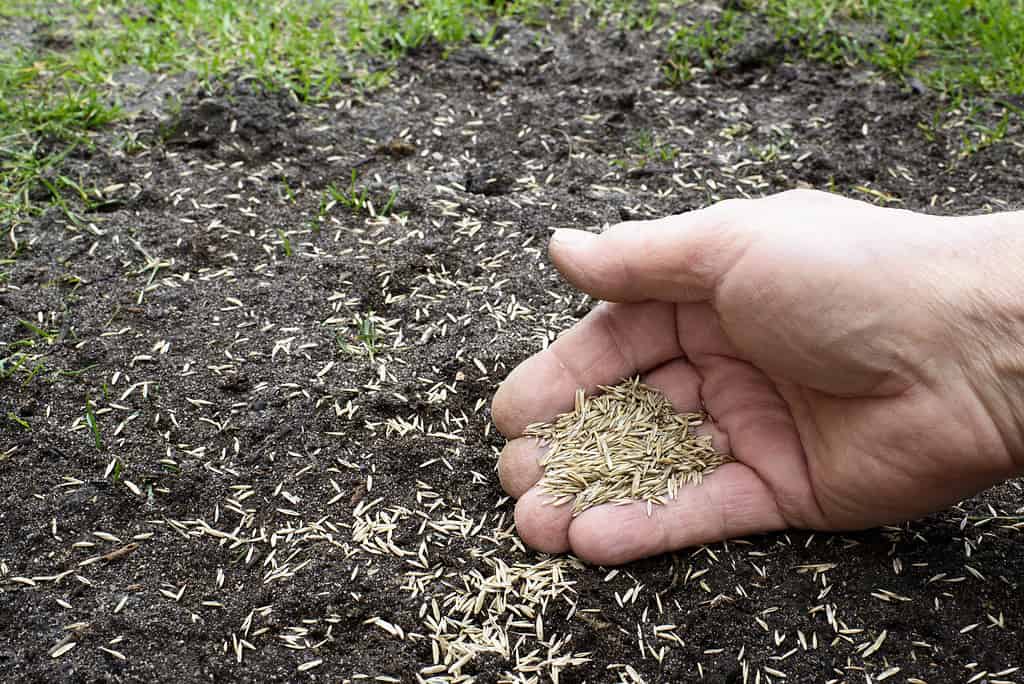
Grass grown from seed can take months to establish.
©iStock.com/
You can grow the grass from seed or lay rolls of ready-grown grass – turf. Growing grass from seed requires warm temperatures and plenty of water. Having prepared the soil and scattered the grass seed, you must protect it from drying out and physical damage while it establishes itself.
Turf is supplied as rolls of grass in a soil layer but must be laid within 24 hours of delivery. The undersoil needs to be prepared by weeding, leveling, and raking. Then, the turf is rolled out on top.
2. Which Gives the Quickest Results?
Artificial Grass
Artificial grass gives immediate results in terms of how it looks. It can be used straight away.
Real Grass
Grass sown from seed can take months to establish, which may require a lot of watering and protection. Turf can usually be used within a few days, but dogs are pretty good at digging it up, so it may also need some protection for some time after!
3. Which Costs More?
Artificial Grass
Artificial grass is more expensive to buy and install. However, it has very little in the way of ongoing costs.
Real Grass
Natural grass is cheaper to buy as seed and turf and more affordable to install. However, ongoing costs include mowing (purchasing and running a lawnmower) and potential irrigation costs, herbicides, and fertilizers.
4. How Long Do They Last?
Artificial Grass
The exact lifespan of the product will depend on the quality of materials used, how well it was installed, how much traffic it gets, and how well you look after it. Most products are guaranteed for eight to ten years and some last much longer.
Real Grass
In theory, natural grass will go on indefinitely. However, patches of it (or all of it if you are unlucky) can get wiped out by droughts, flooding, or over-use.
5. Which Requires More Maintenance?
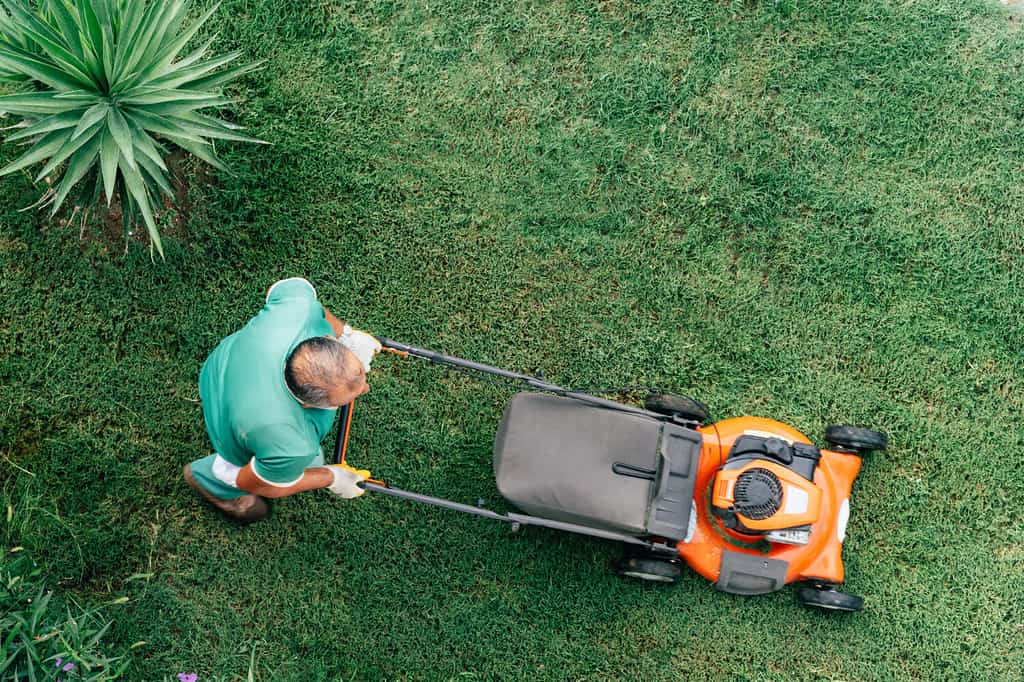
Mowing a lawn is hard work and time-consuming.
©Kryuchka Yaroslav/Shutterstock.com
Artificial Grass
Very little maintenance is required beyond removing leaves and debris. You may need to occasionally apply herbicides to remove stray weeds and use a cleaning solution to remove stains made by pet urine and bird poop.
Real Grass
During the growing season, lawns need to be cut once a week. This can be reduced to once a fortnight at either end of the peak growing season. This takes considerable physical effort, and the grass cuttings must be disposed of. Natural grass must be watered with little rain and may need fertilizer and herbicides to keep them looking their best.
6. Which Looks Best?
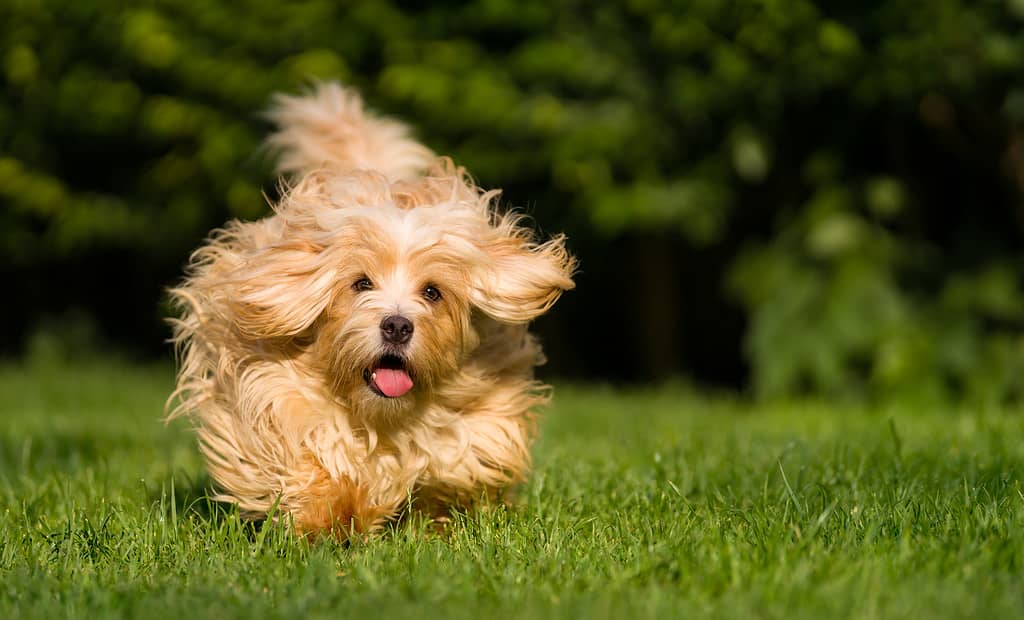
Dogs can wreck natural grass!
©Dorottya_Mathe/iStock via Getty Images
Artificial Grass
Modern artificial grass now has multi-colored blades that intertwine to make them look similar to natural grass. Artificial grass enthusiasts appreciate the uniformity and the fact that it reliably seems the same all year around. However, if there is staining caused by algae or animal waste, it is not so attractive.
Real Grass
Some people prefer the authentic look of natural grass and feel that nothing artificial can match it. However, muddy patches don’t look so great. Many people love the smell of freshly cut grass!
7. Which Is Best for Your Health?
Artificial Grass
Artificial grass is non-toxic, and you will not have to use potentially harmful pesticides, herbicides, or fertilizers. You can easily see and clear up animal waste so it is not hanging around and potentially creating a risk of infection.
Real Grass
Increasing evidence shows that spending time in green spaces reduces stress and improves well-being. For that, you need natural plants. Walking barefoot on grass and ‘earthing’ is increasingly recognized as essential for well-being and may benefit some sleep and chronic disorders. Also, natural grass acts as a sound absorber and reduces the noise of cars, people, and animals, creating a calmer environment.
8. What About Texture and Heat?
Artificial Grass
Artificial lawns have improved dramatically over the last few years, and their texture is much more similar to grass. You, perhaps more importantly, your pets and children, can use your lawn all year round without creating a muddy mess.
On the downside, it may not be somewhere that you can go to cool down in the summer. Artificial grass absorbs heat and then radiates it back. In extreme cases, it can be unpleasant to walk on. If you put a BBQ directly on it, it will melt!
Real Grass
Natural grass absorbs heat and makes your garden cooler in the summer. However, it can become unusable in the winter, especially if poorly drained and muddy.
9. What Are the Environmental Considerations?

Irrigating lawns uses up vast amounts of water.
©iStock.com/MaYcaL
Artificial Grass
This uses less water and reduces herbicides and fertilizers, both of which can damage the environment. On the other hand, it is made from plastic, and its manufacture impacts the environment. This is balanced by using recycled material to make some (but not all) artificial turf products. After use, some manufacturers claim that it can be recycled, but facilities that can recycle this type of material are patchy. Sadly, much of it is in landfills, which can take years to break down. There is also concern that tiny plastic particles can leach into the environment.
To combat this, some artificial grass manufacturers use polyethylene, which they claim does not degrade.
Artificial grass does not provide a habitat for insects or earth-dwelling species; therefore, it does not support the animals that feed on them.
Real Grass
Water is a valuable and limited resource in many areas. This has led to laws requiring the removal of non-functional turf in some parts of the US. Drought-tolerant plants are being suggested as an alternative to thirsty lawns. Lawns are not the most biodiverse options for gardens. You can attract more wildlife by planting various plants and shrubs instead. You use fossil fuels in gas-powered mowers, and you may use fertilizers and herbicides, which can damage local ecosystems.
Nevertheless, an area of natural grass covering 2500 ft.² produces enough oxygen for a family of four to breathe. Moreover, the average lawn can catch 300 pounds of carbon per year. Lawns support hundreds of species of animals, ranging from birds to bacteria.
10. Your Type of Lawn and What You Use It For
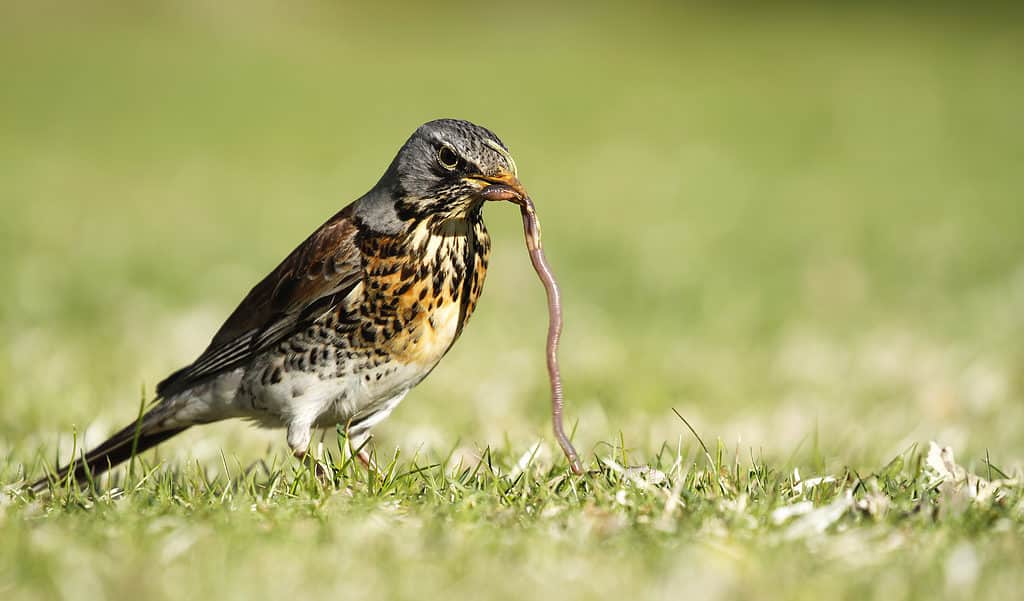
Artificial grass does not support wildlife.
©Jukka Palm/Shutterstock.com
Artificial Grass
You may find that artificial grass is the best option for tiny gardens, urban rooftops, and balconies. It can also be used on existing concrete or tarmac surfaces. It gives a uniform appearance even if you have shady patches on your lawn where natural grass would not grow so well. Artificial turf is also an excellent option for households that do not have the space to store a lawnmower or who have physical limitations that result in them being unable to mow lawns. They are also attractive options for families whose children or dogs have turned their lawns into a muddy mess and provide a clean and safe surface to play on.
Real Grass
Natural grass is usually favored by people who want to spend time in a natural environment and support local wildlife. It is the better option for sloped lawns because artificial grass does not anchor in place so well on slopes. Natural lawns work best in areas with low traffic and more plentiful water.
Summary of Artificial Grass vs Real Grass
| Number | Factor | Artificial Grass | Real Grass |
|---|---|---|---|
| 1 | Which is more difficult to install? | More difficult | Easier |
| 2 | Which gives the quickest results? | Instant after installation | It is expensive to install but lower maintenance costs. |
| 3 | Which costs more? | It is cheaper to install but higher maintenance costs. | Usually around ten years, but it can be more. |
| 4 | How long do they last? | Indefinitely, if not damaged. | It needs regular mowing as a minimum |
| 5 | Which requires more maintenance? | Little needed | Usually around ten years but it can be more. |
| 6 | Which looks best? | Uniform and not patchy | Natural |
| 7 | Which is best for your health? | Requires less herbicides and no fertilizer | It can get hot and will melt under BBQs |
| 8 | What about texture and heat? | It feels natural and absorbs heat | Plastic production impacts the environment, and most end up in landfill after use |
| 9 | What are the environmental considerations? | Chemical treatments can leach into water courses, and they use up water through sprinklers | It gives benefits to the natural environment |
| 10 | Your type of lawn and what you use it for | Best for small gardens, high-traffic areas, and people with physical limitations | Best for slopes, low-traffic lawns, and locations with ample rainfall |
Thank you for reading! Have some feedback for us? Contact the AZ Animals editorial team.

